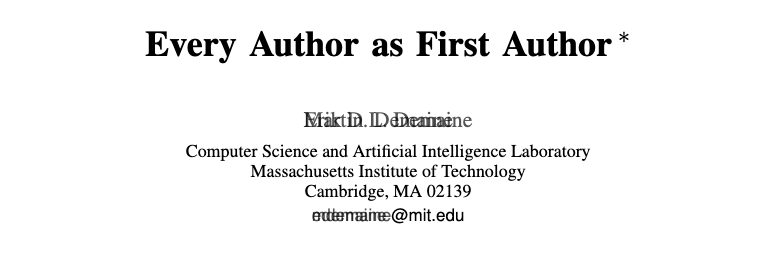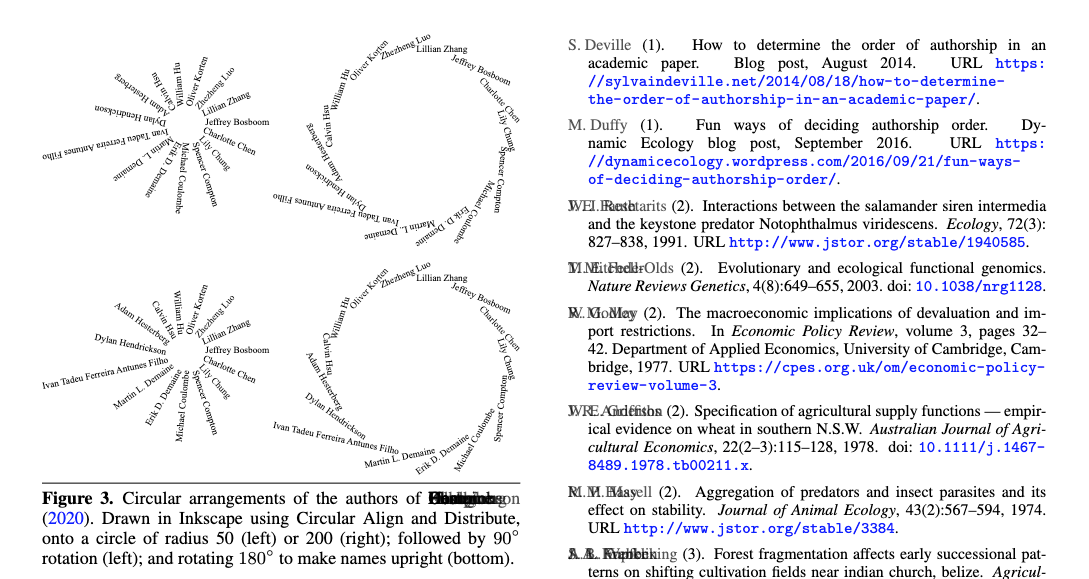Everyone Is First Author?! 📚 The Author Order Revolution You Didn't Know You Needed
-
Everyone Is First Author?!
 The Author Order Revolution You Didn't Know You Needed
The Author Order Revolution You Didn't Know You Needed“Author order is broken... what if we just stacked them all?”
Academic author order has long been a battleground: Who gets the coveted first author position? Who gets buried in the et al.? This issue is more than just vanity — it affects citations, visibility, and even careers. But what if we could sidestep the whole problem?
That’s exactly what MIT researchers Erik Demaine and Martin Demaine propose in their paper:
 “Every Author as First Author” (arXiv:2304.01393)
“Every Author as First Author” (arXiv:2304.01393)And yes, it’s as wild (and clever) as it sounds.
 The Problem: Alphabetical Privilege and Author Inequality
The Problem: Alphabetical Privilege and Author InequalityIn many academic disciplines:
- Economics and mathematics often list authors alphabetically — meaning someone with the last name Anderson gets an unfair advantage over Zhang.
- Natural sciences often follow the “first author = main contributor, last author = PI” convention — but this breaks down in cross-lab collaborations with multiple PIs.
- In citations with >3 authors, most styles shorten to et al., erasing everyone not in front.
This leads to measurable inequality. Studies have shown that authors with early-alphabet names get more citations and faster career progress — a form of alphabetism bias.
And yes, one of the paper’s authors jokingly notes their last name starts with “D.” Coincidence? Maybe not

 The Solution: Name Stacking!
The Solution: Name Stacking!Instead of listing authors linearly, the authors suggest overlaying all names in the same position — literally stacking them on top of each other in the PDF using visual tricks.
 Erik Demaine, Martin Demaine
Erik Demaine, Martin Demaine
 Erik Demaine; Martin Demaine ← visually stacked
Erik Demaine; Martin Demaine ← visually stackedThis creates the illusion that everyone is first, and no one gets buried.

 Figure 1: Stacked Author Names
Figure 1: Stacked Author Names
🧠 How It Works: Tech + Accessibility FTW
This isn’t just typographic wizardry. It’s cleverly engineered:
- On-screen: Each name is overlaid at 2/3 transparency. Overlaps darken slightly, allowing names to remain readable.
- Hover/copy: Thanks to PDF accessibility tags, mousing over or copying the names reveals the full unstacked list in original order.
- LaTeX-ready: They even released a LaTeX macro (
\namestack{}) and tools for HTML and BibTeX. The source code is on GitHub for anyone to adopt.
So it’s both fair and functional.
 Beyond Stacking: The Circular Author List
Beyond Stacking: The Circular Author ListJust in case the vertical stack isn't quirky enough, the paper also experiments with circular author arrangements — where names are placed in a loop to emphasize equality.

 Figure 2: Circular Author Ordering
Figure 2: Circular Author OrderingThis is poetic: circles have no beginning or end. But the paper wryly notes that people may still mentally assign meaning based on position (e.g., “main author at 12 o'clock”?). Cultural habits die hard.
 Existing Approaches & Alphabetical Discrimination
Existing Approaches & Alphabetical DiscriminationThe authors place their solution in the context of existing practices:
- Some disciplines (like economics and theoretical CS) default to alphabetical order to avoid contribution fights.
- Others use collaborative consensus models — but this doesn’t scale for large collaborations.
- The ACM style even clusters papers by first author, reinforcing alphabetical advantage.
This collective set of issues is referred to as alphabetical discrimination. And the consequences aren’t trivial — names at the front often win more citations, grants, and job opportunities.
 ️ Our Take: Fun Idea, Serious Implications
️ Our Take: Fun Idea, Serious ImplicationsThis paper may seem playful, but the underlying critique is deeply valid. As research becomes more interdisciplinary and collaborative, clinging to rigid authorship conventions is increasingly problematic.
While stacking may not become the new standard overnight, it forces us to confront the implicit biases baked into our publishing systems — and gets us thinking creatively about fixing them.
As author order debates heat up, maybe it’s time we think less about who’s first... and more about how everyone contributes.
 Reference:
Reference:- Erik D. Demaine and Martin L. Demaine (2023). "Every Author as First Author." arXiv:2304.01393
 What do you think? Would you adopt name stacking in your next paper? Should journals allow it? Let's discuss!
What do you think? Would you adopt name stacking in your next paper? Should journals allow it? Let's discuss! -
 R root shared this topic on
R root shared this topic on
